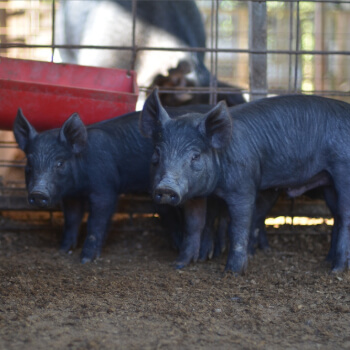Prevent Problems by Walking Pig Barns and Swine Nursery Pens Daily
Jan 06, 2019

Prevent Problems by Walking Pig Barns and Swine Nursery Pens Daily
Daily walks through pig pens are an important part of a successful nursery or grow finish operation. Consistently observing your animals and their environment can help you prevent many challenges.
“The pig barn environment is the No. 1 thing affecting pig performance, and a lot of factors make up that environment,” says Pat Donnelly, a Purina Animal Nutrition Livestock Production Specialist based in northeast Iowa. “If an animal’s not comfortable, it’s not going to perform.”
Pig Barn and Nursery Pen Evaluation Guide

Here are tips for daily evaluations of swine nursery pens from Donnelly and Jacob Wolf, who turns to Donnelly for guidance in the grow finish pig barns Wolf manages for Frye Family Farms near Independence, Iowa.
-
Look at the pig barn as you approach. Do the fans and curtains look consistent? If one is out of line with the others, it could be a red flag.
-
Listen to your pigs before they get up. Do you hear any coughing or sneezing?
-
Look at them from a distance first. How are the pigs positioned in the pen? If they’re spread out and not touching, they’re probably too hot. If they’re piling up, they might be too cold.
-
Walk the swine nursery pens and make sure every pig gets up. The problem pigs are usually the ones hiding in the back corner, Donnelly says. If a pig doesn’t get up, figure out why.
-
Check the feeders in every pen. The goal should be 50 percent pan coverage. More than that could lead to wasted feed. Less could mean pigs aren’t getting enough.
-
Check the feed. Is it fresh and flowing?
-
Walk by air inlets and be sure you feel adequate air flow. Visually inspect fans.
-
Check waterers. Is the water flowing fast enough? Is it spraying too fast? Either could impact water intake, which in turn could impact pig feed intake.
Consistent feed availability and intake is key at any growth phase, Donnelly says.
“Any break in feed intake can cause set-backs that impact current performance and can exponentially impact future performance,” he says. “Success comes down to being willing to pay attention to the most basic details, even when it feels boring,” Donnelly says. “Time spent getting the basics right will keep your pigs performing and your facilities working the way they should.”
If you find stressed pigs that are not eating or drinking, UltraCare® gel is an easy-to-use product that can help fast and keep pigs on track for long-term performance.